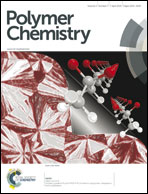One-step electropolymerization of xanthurenic acid–graphene film prepared by a pulse potentiostatic method for simultaneous detection of guanine and adenine†
Abstract
A novel one-step electrochemical synthesis via a pulse potentiostatic method (PPM) was adopted to prepare a nanocomposite of poly(xanthurenic acid, Xa)–electrochemically reduced graphene oxide (PXa–ERGNO), which was applied for simultaneous detection of guanine and adenine. In the synthesis process, the graphene oxide (GNO) could be electrochemically reduced to reduced graphene oxide in the cathodic potential section; meanwhile, Xa (an unconventional and low toxicity biomonomer) could be electropolymerized in the anodic potential section. The optimization of fabrication was based on the electrooxidation signals of DNA bases. Since the negative charge and specific structure of the nanocomposite can prompt the adsorption of the electropositive guanine and adenine via strong π–π* interactions or electrostatic adsorption, the resulting nanocomposite shows high electrocatalytic ability for the detection of guanine and adenine.


 Please wait while we load your content...
Please wait while we load your content...